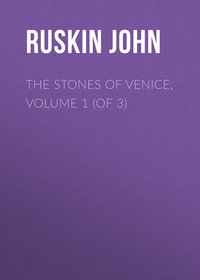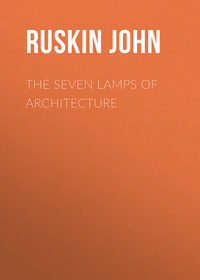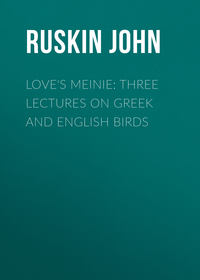 полная версия
полная версияArrows of the Chace, vol. 1/2
January 6.
[From “The Times,” December 29, 1852.]
THE NATIONAL GALLERY
To the Editor of “The Times.”
Sir: I trust that the excitement which has been caused by the alleged destruction of some of the most important pictures in the National Gallery will not be without results, whatever may be the facts of the case with respect to the works in question. Under the name of “restoration,” the ruin of the noblest architecture and painting is constant throughout Europe. We shall show ourselves wiser than our neighbors if the loss of two Claudes and the injury of a Paul Veronese48 induce us to pay so much attention to the preservation of ancient art as may prevent it from becoming a disputed question in future whether they are indeed pictures which we possess or their skeletons.
As to the facts in the present instance, I can give no opinion. Sir Charles Eastlake and Mr. Uwins49 know more than I of oil paintings in general, and have far more profound respect for those of Claude in particular. I do not suppose they would have taken from him his golden armor that Turner might bear away a dishonorable victory in the noble passage of arms to which he has challenged his rival from the grave.50 Nor can the public suppose that the Curators of the National Gallery have any interest in destroying the works with which they are intrusted. If, acting to the best of their judgment, they have done harm, to whom are we to look for greater prudence or better success? Are the public prepared to withdraw their confidence from Sir C. Eastlake and the members of the Royal Academy, and entrust the national property to Mr. Morris Moore, or to any of the artists and amateurs who have inflamed the sheets of The Times with their indignation? Is it not evident that the only security which the nation can possess for its pictures must be found in taking such measures as may in future prevent the necessity of their being touched at all? For this is very certain, that all question respecting the effects of cleaning is merely one of the amount of injury. Every picture which has undergone more friction than is necessary at intervals for the removal of dust or dirt, has suffered injury to some extent. The last touches of the master leave the surface of the color with a certain substantial texture, the bloom of which, if once reached under the varnish, must inevitably be more or less removed by friction of any kind—how much more by friction aided by solvents? I am well assured that every possessor of pictures who truly loves them, would keep—if it might be—their surfaces from being so much as breathed upon, which may, indeed, be done, and done easily.
Every stranger who enters our National Gallery, if he be a thoughtful person, must assuredly put to himself a curious question. Perceiving that certain pictures—namely, three Correggios, two Raphaels and a John Bellini—are put under glass,51 and that all the others are left exposed, as oil pictures are in general, he must ask himself, “Is it an ascertained fact that glass preserves pictures; and are none of the pictures here thought worth a pane of glass but these five?52 Or is it unascertained whether glass is beneficial or injurious, and have the Raphaels and Correggios been selected for the trial—‘Fiat experimentum in corpore vili?’ ” Some years ago it might have been difficult to answer him; now the answer is easy, though it be strange. The experiment has been made. The Raphaels and Correggios have been under glass for many years: they are as fresh and lovely as when they were first enclosed; they need no cleaning, and will need none for half a century to come; and it must be, therefore, that the rest of the pictures are left exposed to the London atmosphere, and to the operations which its influence renders necessary, simply because they are not thought worth a pane of plate glass. No: there is yet one other possible answer—that many of them are hung so high, or in such lights, that they could not be seen if they were glazed. Is it then absolutely necessary that they should be hung so high? We are about to build a new National Gallery; may it not be so arranged as that the pictures we place therein may at once be safe and visible?
I know that this has never yet been done in any gallery in Europe, for the European public have never yet reflected that a picture which was worth buying was also worth seeing. Some time or other they will assuredly awake to the perception of this wonderful truth, and it would be some credit to our English common-sense if we were the first to act upon it.
I say that a picture which is worth buying is also worth seeing; that is, worth so much room of ground and wall as shall enable us to see it to the best advantage. It is not commonly so understood. Nations, like individuals, buy their pictures in mere ostentation; and are content, so that their possessions are acknowledged, that they should be hung in any dark or out-of-the-way corners which their frames will fit. Or, at best, the popular idea of a national gallery is that of a magnificent palace, whose walls must be decorated with colored panels, every one of which shall cost £1,000, and be discernible, through a telescope, for the work of a mighty hand.
I have no doubt that in a few years more there will be a change of feeling in this matter, and that men will begin to perceive, what is indeed the truth—that every noble picture is a manuscript book, of which only one copy exists, or ever can exist; that a national gallery is a great library,53 of which the books must be read upon their shelves; but every manuscript ought, therefore, to be placed where it can be read most easily; and that the style of the architecture and the effect of the saloons are matters of no importance whatsoever, but that our solicitude ought to begin and end in the two imperative requirements—that every picture in the gallery should be perfectly seen and perfectly safe; that none should be thrust up, or down, or aside, to make room for more important ones; that all should be in a good light, all on a level with the eye, and all secure from damp, cold, impurity of atmosphere, and every other avoidable cause of deterioration.
These are the things to be accomplished; and if we set ourselves to do these in our new National Gallery,54 we shall have made a greater step in art-teaching than if we had built a new Parthenon. I know that it will be a strange idea to most of us that Titians and Tintorets ought, indeed, all to have places upon “the line,” as well as the annual productions of our Royal Academicians; and I know that the coup d’œil of the Gallery must be entirely destroyed by such an arrangement. But great pictures ought not to be subjects of “coups d’œil.” In the last arrangement of the Louvre, under the Republic, all the noble pictures in the gallery were brought into one room, with a Napoleon-like resolution to produce effect by concentration of force; and, indeed, I would not part willingly with the memory of that saloon, whose obscurest shadows were full of Correggio; in whose out-of-the-way angles one forgot, here and there, a Raphæl; and in which the best Tintoret on this side of the Alps was hung sixty feet from the ground!55 But Cleopatra dissolving the pearl was nothing to this; and I trust that, in our own Gallery, our poverty, if not our will, may consent to a more modest and less lavish manner of displaying such treasures as are intrusted to us; and that the very limitation of our possessions may induce us to make that the object of our care which can hardly be a ground of ostentation. It might, indeed, be a matter of some difficulty to conceive an arrangement of the collections in the Louvre or the Florence Gallery which should admit of every picture being hung upon the line. But the works in our own, including the Vernon and Turner bequests,56 present no obstacle in their number to our making the building which shall receive them a perfect model of what a National Gallery ought to be. And the conditions of this perfection are so simple that if we only turn our attention to these main points it will need no great architectural ingenuity to attain all that is required.
It is evident, in the first place, that the building ought to consist of a series of chambers or galleries lighted from above, and built with such reference to the pictures they are to contain, as that opposite a large picture room enough should be allowed for the spectator to retire to the utmost distance at which it can ever be desirable that its effect should be seen; but, as economy of space would become a most important object when every picture was to be hung on a level with the eye, smaller apartments might open from the larger ones for the reception of smaller pictures, one condition being, however, made imperative, whatever space was sacrificed to it—namely, that the works of every master should be collected together, either in the same apartment or in contiguous ones. Nothing has so much retarded the advance of art as our miserable habit of mixing the works of every master and of every century. More would be learned by an ordinarily intelligent observer in simply passing from a room in which there were only Titians, to another in which there were only Caraccis, than by reading a volume of lectures on color. Few minds are strong enough first to abstract and then to generalize the characters of paintings hung at random. Few minds are so dull as not at once to perceive the points of difference, were the works of each painter set by themselves. The fatigue of which most persons complain in passing through a picture gallery, as at present arranged, is indeed partly caused by the straining effort to see what is out of sight, but not less by the continual change of temper and of tone of thought, demanded in passing from the work of one master to that of another.
The works of each being, therefore, set by themselves,57 and the whole collection arranged in chronological and ethnological order, let apartments be designed for each group large enough to admit of the increase of the existing collection to any probable amount. The whole gallery would thus become of great length, but might be adapted to any form of ground-plan by disposing the whole in a labyrinthine chain, returning upon itself. Its chronological arrangement would necessitate its being continuous, rather than divided into many branches or sections. Being lighted from above, it must be all on the same floor, but ought at least to be raised one story above the ground, and might admit any number of keepers’ apartments, or of schools, beneath; though it would be better to make it quite independent of these, in order to diminish the risk of fire. Its walls ought on every side to be surrounded by corridors, so that the interior temperature might be kept equal, and no outer surface of wall on which pictures were hung exposed to the weather. Every picture should be glazed, and the horizon which the painter had given to it placed on a level with the eye.
Lastly, opposite each picture should be a table, containing, under glass, every engraving that had ever been made from it, and any studies for it, by the master’s own hand, that remained, or were obtainable. The values of the study and of the picture are reciprocally increased—of the former more than doubled—by their being seen together; and if this system were once adopted, the keepers of the various galleries of Europe would doubtless consent to such exchanges of the sketches in their possession as would render all their collections more interesting.
I trust, Sir, that the importance of this subject will excuse the extent of my trespass upon your columns, and that the simplicity and self-evident desirableness of the arrangement I have described may vindicate my proposal of it from the charge of presumption.
I have the honor to be, Sir,Your obedient servant,The Author of “Modern Painters.”Herne Hill, Dulwich, Dec. 27.
[From “The Times,” January 27, 1866.]
THE BRITISH MUSEUM
To the Editor of “The Times.”
Sir: As I see in your impression of yesterday that my name was introduced in support of some remarks made, at the meeting of the Society of Arts, on the management of the British Museum,58 and as the tendency of the remarks I refer to was depreciatory of the efforts and aims of several officers of the Museum—more especially of the work done on the collection of minerals by my friend Mr. Nevil S. Maskelyne59—you will, I hope, permit me, not having been present at the meeting, to express my feeling on the subject briefly in your columns.
There is a confused notion in the existing public mind that the British Museum was partly a parish school, partly a circulating library, and partly a place for Christmas entertainments.
It is none of the three, and, I hope, will never be made any of the three. But especially and most distinctly it is not a “preparatory school,” nor even an “academy for young gentlemen,” nor even a “working-men’s college.” A national museum is one thing, a national place of education another; and the more sternly and unequivocally they are separated, the better will each perform its office—the one of treasuring and the other of teaching. I heartily wish that there were already, as one day there must be, large educational museums in every district of London, freely open every day, and well lighted and warmed at night, with all furniture of comfort, and full aids for the use of their contents by all classes. But you might just as rationally send the British public to the Tower to study mineralogy upon the Crown jewels as make the unique pieces of a worthy national collection (such as, owing mainly to the exertions of its maligned officers, that of our British Museum has recently become) the means of elementary public instruction. After men have learnt their science or their art, at least so far as to know a common and a rare example in either, a national museum is useful, and ought to be easily accessible to them; but until then, unique or selected specimens in natural history are without interest to them, and the best art is as useless as a blank wall. For all those who can use the existing national collection to any purpose, the Catalogue as it now stands is amply sufficient: it would be difficult to conceive a more serviceable one. But the rapidly progressive state of (especially mineralogical) science, renders it impossible for the Curators to make their arrangements in all points satisfactory, or for long periods permanent. It is just because Mr. Maskelyne is doing more active, continual, and careful work than, as far as I know, is at present done in any national museum in Europe—because he is completing gaps in the present series by the intercalation of carefully sought specimens, and accurately reforming its classification by recently corrected analyses—that the collection cannot yet fall into the formal and placid order in which an indolent Curator would speedily arrange and willingly leave it.
I am glad that Lord H. Lennox referred to the passage in my report on the Turner Collection in which I recommended that certain portions of that great series should be distributed, for permanence, among our leading provincial towns.60 But I had rather see the whole Turner Collection buried, not merely in the cellars of the National Gallery, but with Prospero’s staff fathoms in the earth, than that it should be the means of inaugurating the fatal custom of carrying great works of art about the roads for a show. If you must make them educational to the public, hang Titian’s Bacchus up for a vintner’s sign, and give Henry VI.’s Psalter61 for a spelling-book to the Bluecoat School; but, at least, hang the one from a permanent post, and chain the other to the boys’ desks, and do not send them about in caravans to every annual Bartholomew Fair.
I am, Sir, your obedient servant,J. Ruskin.Denmark Hill, Jan. 26.
[From “The Leicester Chronicle and Mercury,” January 31, and reprinted in “The Times,” February 2, 1880.]
ON THE PURCHASE OF PICTURES
Dear Sir: Your letter is deeply interesting to me, but what use is there in my telling you what to do? The mob won’t let you do it. It is fatally true that no one nowadays can appreciate pictures by the Old Masters! and that every one can understand Frith’s “Derby Day”—that is to say, everybody is interested in jockeys, harlots, mountebanks, and men about town; but nobody in saints, heroes, kings, or wise men—either from the east or west. What can you do? If your Committee is strong enough to carry such a resolution as the appointment of any singly responsible person, any well-informed gentleman of taste in your neighborhood, to buy for the Leicester public just what he would buy for himself—that is to say, himself and his family—children being the really most important of the untaught public—and to answer simply to all accusation—that is, a good and worthy piece of art (past or present, no matter which)—make the most and best you can of it. That method so long as tenable will be useful. I know of no other.
Faithfully yours,J. Ruskin.62III.
PRE-RAPHAELITISM
[From “The Times,” May 13, 1851.]
THE PRE-RAPHAELITE BRETHREN
To the Editor of “The Times.”
Sir: Your usual liberality will, I trust, give a place in your columns to this expression of my regret that the tone of the critique which appeared in The Times of Wednesday last on the works of Mr. Millais and Mr. Hunt, now in the Royal Academy, should have been scornful as well as severe.63
I regret it, first, because the mere labor bestowed on those works, and their fidelity to a certain order of truth (labor and fidelity which are altogether indisputable), ought at once to have placed them above the level of mere contempt; and, secondly, because I believe these young artists to be at a most critical period of their career—at a turning-point, from which they may either sink into nothingness or rise to very real greatness; and I believe also, that whether they choose the upward or the downward path, may in no small degree depend upon the character of the criticism which their works have to sustain. I do not wish in any way to dispute or invalidate the general truth of your critique on the Royal Academy; nor am I surprised at the estimate which the writer formed of the pictures in question when rapidly compared with works of totally different style and aim; nay, when I first saw the chief picture by Millais in the Exhibition of last year,64 I had nearly come to the same conclusion myself. But I ask your permission, in justice to artists who have at least given much time and toil to their pictures, to institute some more serious inquiry into their merits and faults than your general notice of the Academy could possibly have admitted.
Let me state, in the first place, that I have no acquaintance with any of these artists, and very imperfect sympathy with them. No one who has met with any of my writings will suspect me of desiring to encourage them in their Romanist and Tractarian tendencies.65 I am glad to see that Mr. Millais’ lady in blue66 is heartily tired of her painted window and idolatrous toilet table; and I have no particular respect for Mr. Collins’ lady in white, because her sympathies are limited by a dead wall, or divided between some gold fish and a tadpole—(the latter Mr. Collins may, perhaps, permit me to suggest en passant, as he is already half a frog, is rather too small for his age). But I happen to have a special acquaintance with the water plant, Alisma Plantago, among which the said gold fish are swimming; and as I never saw it so thoroughly or so well drawn, I must take leave to remonstrate with you, when you say sweepingly that these men “sacrifice truth as well as feeling to eccentricity.” For as a mere botanical study of the water-lily and Alisma, as well as of the common lily and several other garden flowers, this picture would be invaluable to me, and I heartily wish it were mine.
But, before entering into such particulars, let me correct an impression which your article is likely to induce in most minds, and which is altogether false. These pre-Raphaelites (I cannot compliment them on common-sense in choice of a nom de guerre) do not desire nor pretend in any way to imitate antique painting as such. They know very little of ancient paintings who suppose the works of these young artists to resemble them.67 As far as I can judge of their aim—for, as I said, I do not know the men themselves—the pre-Raphaelites intend to surrender no advantage which the knowledge or inventions of the present time can afford to their art. They intend to return to early days in this one point only—that, as far as in them lies, they will draw either what they see, or what they suppose might have been the actual facts of the scene they desire to represent, irrespective of any conventional rules of picture-making; and they have chosen their unfortunate though not inaccurate name because all artists did this before Raphael’s time, and after Raphael’s time did not this, but sought to paint fair pictures, rather than represent stern facts; of which the consequence has been that, from Raphael’s time to this day, historical art has been in acknowledged decadence.
Now, sir, presupposing that the intention of these men was to return to archaic art instead of to archaic honesty, your critic borrows Fuseli’s expression respecting ancient draperies “snapped instead of folded,” and asserts that in these pictures there is a “servile imitation of false perspective.” To which I have just this to answer:
That there is not one single error in perspective in four out of the five pictures in question; and that in Millais’ “Mariana” there is but this one—that the top of the green curtain in the distant window has too low a vanishing-point; and that I will undertake, if need be, to point out and prove a dozen worse errors in perspective in any twelve pictures, containing architecture, taken at random from among the works of the popular painters of the day.
Secondly: that, putting aside the small Mulready, and the works of Thorburn and Sir W. Ross, and perhaps some others of those in the miniature room which I have not examined, there is not a single study of drapery in the whole Academy, be it in large works or small, which for perfect truth, power, and finish could be compared for an instant with the black sleeve of the Julia, or with the velvet on the breast and the chain mail of the Valentine, of Mr. Hunt’s picture; or with the white draperies on the table of Mr. Millais’ “Mariana,” and of the right-hand figure in the same painter’s “Dove returning to the Ark.”
And further: that as studies both of drapery and of every minor detail, there has been nothing in art so earnest or so complete as these pictures since the days of Albert Dürer. This I assert generally and fearlessly. On the other hand, I am perfectly ready to admit that Mr. Hunt’s “Silvia” is not a person whom Proteus or any one else would have been likely to fall in love with at first sight; and that one cannot feel very sincere delight that Mr. Millais’ “Wives of the Sons of Noah” should have escaped the Deluge; with many other faults besides, on which I will not enlarge at present, because I have already occupied too much of your valuable space, and I hope to enter into more special criticism in a future letter.
I have the honor to be, Sir,Your obedient servant,The Author of “Modern Painters.”Denmark Hill, May 9.
[From “The Times,” May 30, 1851.]
THE PRE-RAPHAELITE BRETHREN
To the Editor of “The Times.”
Sir: Your obliging insertion of my former letter encourages me to trouble you with one or two further notes respecting the pre-Raphaelite pictures. I had intended, in continuation of my first letter, to institute as close an inquiry as I could into the character of the morbid tendencies which prevent these works from favorably arresting the attention of the public; but I believe there are so few pictures in the Academy whose reputation would not be grievously diminished by a deliberate inventory of their errors, that I am disinclined to undertake so ungracious a task with respect to this or that particular work. These points, however, may be noted, partly for the consideration of the painters themselves, partly that forgiveness of them may be asked from the public in consideration of high merits in other respects.









